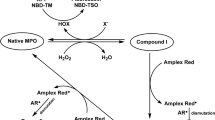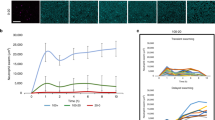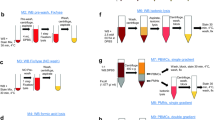Abstract
On phagocytosing a microorganism, the neutrophil zpolymor-phonuclear leukocyte, PMN) consumes oxygen at a sharply elevated rate1. The oxygen is used to kill the microorganism, presumably being used to produce a potent oxidizing agent or agents. Candidates for these bactericidal agents are singlet oxygen, hydroxyl radical and chlorinating agents (that is, species containing ‘active’ Cl in a formal +1 oxidation state: HOCl, Cl2, N-chloroamides, and so on)1–5. We now report a semiquantitative assay for PMN-generated active chlorine based on its trapping with 1,3,5-trimethoxybenzene (TMB). Using this assay, we have found that at least 28% of the oxygen consumed by stimulated normal human PMNs is converted to active chlorinating agents.
This is a preview of subscription content, access via your institution
Access options
Subscribe to this journal
Receive 51 print issues and online access
$199.00 per year
only $3.90 per issue
Buy this article
- Purchase on Springer Link
- Instant access to full article PDF
Prices may be subject to local taxes which are calculated during checkout
Similar content being viewed by others
References
Klebanoff, S. J. & Clark, R. A. The Neutrophil: Function and Clinical Disorders (North-Holland, Amsterdam, 1978).
Klebanoff, S. J. Ann. int. Med. 93, 480–489 (1980).
Weiss, S. J. & LoBuglio, A. F. Lab. Invest. 47, 5–18 (1982).
Root, R. K. & Cohen, M. S. Rev. infect. Dis. 3, 565–598 (1981).
Gabig, T. G. & Babior, B. M. A. Rev. Med. 32, 313–326 (1981).
Foote, C. S., Abakerli, R. B., Clough, R. L. & Lehrer, R. I. in Bioluminescence and Chemiluminescence (eds DeLuca, M. A. & McElroy, W. D.) 81–88 (Academic, New York, 1981).
Foote, C. S., Abakerli, R. B., Clough, R. L. & Shook, F. C. in Biological and Clinical Aspects of Superoxide and Superoxide Dismutase (eds Bannister, W. H. & Bannister, J. V.) 222–230 (Eisevier, New York, 1980).
Klebanoff, S. J. J. exp. Med. 126, 1063–1078 (1967).
Thomas, E. L. Infect. Immunity 23, 522–531 (1979).
Stelmaszynska, T. & Zgliczynski, J. M. Eur. J. Biochem. 45, 305–312 (1974).
Harrison, J. E. & Schultz, J. J. biol. Chem. 251, 1371–1374 (1976).
Sips, H. J. & Harners, M. N. Infect. Immunity 31, 11–16 (1981).
Albrich, J. M., McCarthy, C. A. & Hurst, J. K. Proc. natn. Acad. Sci. U.S.A. 78, 210–214 (1981).
Weiss, S. J., Klein, R., Slivka, A. & Wei, M. J. clin. Invest. 70, 598–607 (1982).
Castelfranchi, G. & Borra, G. Ann. Chim. (Rome) 43, 293–297 (1953).
Clark-Lewis, J. W. Aust. J. Chem. 10, 505–506 (1957).
Hohn, D. C. & Lehrer, R. I. J. clin. Invest. 55, 707–713 (1975).
Author information
Authors and Affiliations
Rights and permissions
About this article
Cite this article
Foote, C., Goyne, T. & Lehrer, R. Assessment of chlorination by human neutrophils. Nature 301, 715–716 (1983). https://doi.org/10.1038/301715a0
Received:
Accepted:
Issue Date:
DOI: https://doi.org/10.1038/301715a0
This article is cited by
-
The effects of neutrophil-generated hypochlorous acid and other hypohalous acids on host and pathogens
Cellular and Molecular Life Sciences (2021)
-
Chlorinative stress in age-related diseases: a literature review
Immunity & Ageing (2017)
-
Mutagenic consequences of cytosine alterations site-specifically embedded in the human genome
Genes and Environment (2016)
-
In Vitro Oxidation of Collagen Promotes the Formation of Advanced Oxidation Protein Products and the Activation of Human Neutrophils
Inflammation (2016)
-
Allopurinol improves endothelial function and reduces oxidant-inflammatory enzyme of myeloperoxidase in metabolic syndrome
Clinical Research in Cardiology (2008)
Comments
By submitting a comment you agree to abide by our Terms and Community Guidelines. If you find something abusive or that does not comply with our terms or guidelines please flag it as inappropriate.



